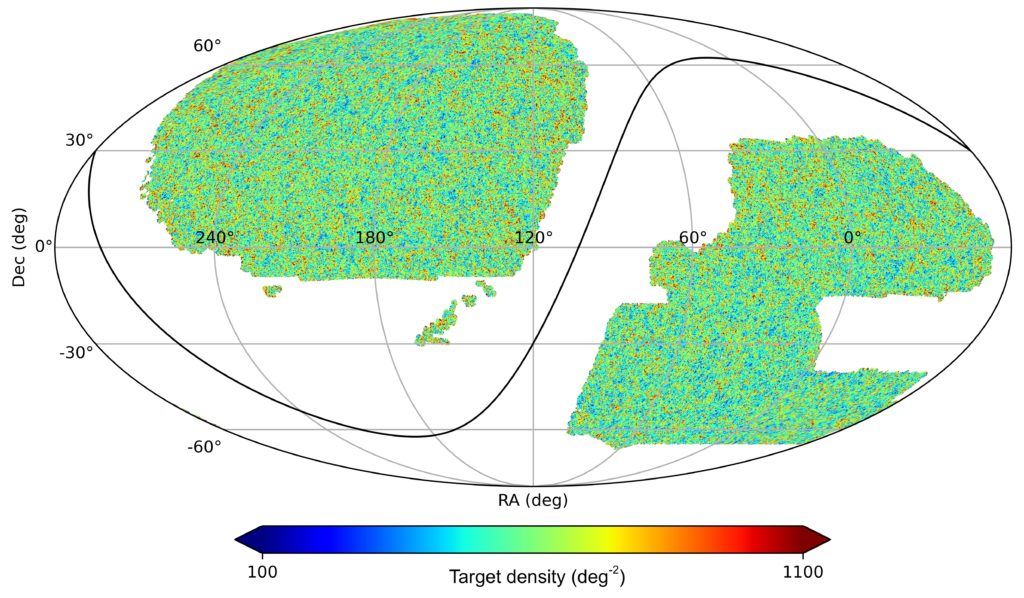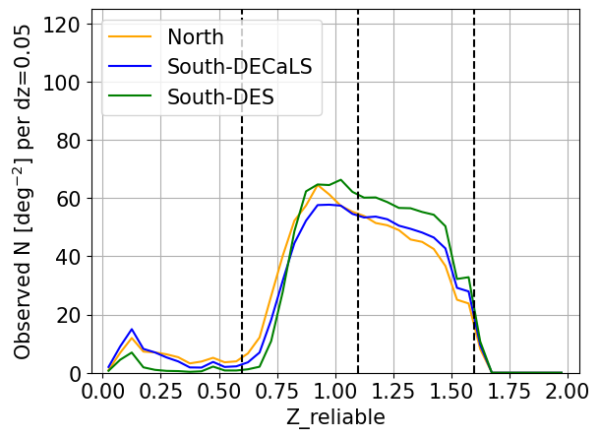DESI Bright Galaxy Survey: Final Target Selection, Design, and Validation
Target Selection and Validation of DESI Luminous Red Galaxies
This paper describes how we select luminous red galaxies—massive galaxies that are particularly useful for mapping out large-scale structures—to be observed by DESI. The plot shows the density of these galaxies on the sky, and DESI will turn 2D maps like this into 3D!
Target Selection and Validation of DESI Emission Line Galaxies
The Emission Line Galaxies (ELGs) will constitute about a third of the 40 million extragalactic redshifts that DESI will observe. They will cover the 0.6 < z < 1.6 redshift range, with being key in 1.1 < z < 1.6 for the large-scale structure measurements. This paper presents:

- how those ELG targets are selected: with a g-band fiber magnitude cut and a simple box in the g–r versus r–z color—color diagram;
- their photometric properties: ELGs are faint in imaging, due to the requested high density, and such are more sensitive to variations in the imaging than other DESI tracers;
- their spectroscopic properties: based on the Survey Validation data and 2021 Main Survey data, we define a simple, preliminary criterion to select reliable redshifts, using the [OII] doublet signal-to-noise ratio, and demonstrate they will meet the DESI requirements.
Target Selection and Validation of DESI Quasars
 The Dark Energy Spectroscopic Instrument (DESI) survey will measure large-scale structures using quasars as direct tracers of dark matter in the redshift range 0.9 < z < 2.1. We present several methods to select candidate quasars for DESI, using input photometric imaging in three optical bands (g, r, z) from the DESI Legacy Imaging Surveys and two infrared bands (W1, W2) from the Wide-field Infrared Explorer (WISE). These methods were extensively tested during the Survey Validation of DESI. With a target density of 310 per square degree, the main selection allows DESI to select more than 200 quasars per square degree, exceeding the project requirements by 20%. The redshift distribution of the selected quasars is in excellent agreement with quasar luminosity function predictions as shown in the figure.
The Dark Energy Spectroscopic Instrument (DESI) survey will measure large-scale structures using quasars as direct tracers of dark matter in the redshift range 0.9 < z < 2.1. We present several methods to select candidate quasars for DESI, using input photometric imaging in three optical bands (g, r, z) from the DESI Legacy Imaging Surveys and two infrared bands (W1, W2) from the Wide-field Infrared Explorer (WISE). These methods were extensively tested during the Survey Validation of DESI. With a target density of 310 per square degree, the main selection allows DESI to select more than 200 quasars per square degree, exceeding the project requirements by 20%. The redshift distribution of the selected quasars is in excellent agreement with quasar luminosity function predictions as shown in the figure.
Overview of the DESI Milky Way Survey
The paper introduces the DESI Milky Way Survey (MWS), which will observe ~7 million faint stars over five years, including many more than ever before in the most distant parts of our galaxy. These observations will shed light on the ancient history of the Milky Way and the nature of dark matter. We use 100,000 early observations to show that DESI’s performance is sufficient to meet the goals of MWS.
The DESI Survey Validation: Visually Inspected Redshift Catalogs of Bright Galaxies, Luminous Red Galaxies, and Emission Line Galaxies
DESI is targeting three different types of galaxies, and after looking at about 17,000 spectra we can conclude that DESI is on track to get very precise distance measurements. The image below is a snapshot of the tool used to inspect individual spectra and shows the spectrum of an emission line galaxy at redshift of 1.45.

The DESI Survey Validation: Results from Visual Inspection of the Quasar Survey Spectra
The Target Selection Pipeline for the Dark Energy Spectroscopic Instrument
This paper describes the DESI target selection pipeline and how it was applied to select DESI targets. The paper includes technical details about DESI targets, such as the unique DESI targeting ID and selection bitmasks. The paper also outlines the selection of calibration targets, such as standard stars, guide focus array (GFA) targets and sky locations.